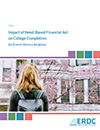This study is about a group of students who entered public higher education in Washington State in the first year after high school graduation. All of the students received need-based financial aid in the first year of attending college. They are followed for six years. The students are stratified into quartiles based on the percentage of financial aid they received as a share of their financial need. Study highlights include:
Students with better financial aid packages complete at higher rates and at a faster pace than students with lesser financial aid packages
Students who have a higher percentage of their financial need met by need-based financial aid are more likely to complete college and do so earlier. This pattern is consistent for the four cohorts of the study (men and women who began at a 4-year institution and men and women who began at a community or technical college). On average, the students in the highest (4th) quartile of financial aid as a percent of need completed at higher rates and sooner than students in the next (3rd) quartile; students in the third quartile completed at higher rates and sooner than students in the second quartile; and students in the second quartile completed at higher rates and sooner than students in the lowest (1st) quartile.
Needy students who receive greater amounts of financial aid are more likely to attend full-time; or, alternatively, needy students who attend college full-time are more likely to receive greater amounts of financial aid
The causality is not clear:
- Are needy students who attend college full-time more likely to receive greater amounts of financial aid?; or
- Are needy students who receive higher amounts of aid compared to their need more likely to attend college full-time?
In either case the evidence is that the students who have higher amounts of their financial need met by financial aid are also are more likely to attend college full-time and earn more college-level credits. This pattern holds for the first four years for all four cohorts and the four quartiles of aid recipients. After the fourth year the pattern begins to break down as the remaining students who have not completed or dropped out are more likely to be attending college part-time.
Student who did not receive financial aid in the second year were less likely to complete
All students in this study received need-based financial aid in their first year of college. Not all of the students who continued after the first year received aid in the second year. Of the students who continued, 85 percent received aid and 15 percent did not. The students who did not receive need-based aid in the second year were more likely to be attending less than full-time, more likely to be working, and less likely to graduate.
The amount of unmet need for students still receiving aid increases every year and the problem is worse for the students with lesser aid packages
Unmet need is the difference between a student’s financial need and the amount of financial aid received by the student. The amount of unmet need tends to increase from year-to-year as need-based aid does not keep pace with financial need. Financial need is the difference between the cost of attending a university or college and the expected family contribution toward that cost. As the costs go up (and/or the expected family contributions go down), financial need increases. Students with the better financial aid packages see year-to-year increases in the amount of aid – but not as much as the increase in financial need. The lesser aid packages remain relatively constant from year-to-year. Thus, these students have a bigger problem with unmet need.
Students with the lowest financial aid package drop out at substantially higher rates, but even a bit more financial aid goes a long way toward decreasing dropout rates
The students who had the least amount of their financial need met by financial aid drop out at the highest rates. However, there is not such a clear distinction among the students in the top quarter of financial aid recipients and the middle half of students. Generally, the average dropout rate for students in the second quartile is closer to the average dropout rate in the highest quartile than to the lowest quartile.


